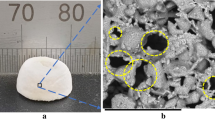Abstract
Spatial development of mouse bone marrow cellsemploying porous carriers was investigated in order todesign a bioreactor with a three-dimensionalhematopoietic microenvironment. Three types of porouscarriers were used for examining the spatialdevelopment of anchorage-dependent primary stromalcells as feeder cells. Stromal cells were found tospread well at a high density on a polyester nonwovendisc carrier (Fibra cel (FC)) under a scanningelectron microscope, while cells on porous cellulosebeads (Microcube (MC), 500 μm pore diameter)spread at a low density; cells on another type ofcellulose porous beads (CPB, 100 μm pore diameter)were globular. Mouse bone marrow cells wereinoculated to dishes containing three types of porouscarriers which shared more than 30% of the bottomsurface in a dish. The concentration of stromal cellsin the well containing FC was lower than that on theother two carriers. However, the weekly output oftotal hematopoietic cell (suspension cells) increasedbetween day 21 and 28 in the culture using FC while itdecreased monotonously in the cultures by use of theother two carriers. The proportion of progenitorcells (BFU-E, CFU-GM) in the total hematopoietic cellpopulation, after showing an initial decrease,increased after 1 week in the culture using FC whilethe proportion decreased monotonously to zero in thecultures using MC and CPB.
Similar content being viewed by others
References
Broxmeyer HE, Douglas GW, Hangoc G, Cooper S, Bard J, English D, Arny M, Thomas L and Boyse EA (1989) Human umbilical cord blood as a potential source of transplantable hematopoietic stem/progenitor cells. Proc Natl Acad Sci USA 86: 3828–3832.
Broxmeyer HE, Hangoc G, Cooper S, Ribeiro RC, Graves V, Yoder M, Wagner J, Vandhan-Raj S, Benninger L, Rubinstein P and Broun ER (1992) Growth characteristics and expansion of human umbilical cord blood and estimation of its potential for transplantation in adults. Proc Natl Acad Sci USA 89: 4109–4113.
Dexter TM, Allen TD and Lajtha LG (1977) Conditions controlling the proliferation of hematopoietic stem cells in vitro. J Cell Physiol 91: 335–339.
Emerson SG (1996) Ex vivo expansion of hematopoietic precursors, progenitors, and stem cells. Blood 87: 3082–3088.
Knospe WH, Husseini SG, Zipori D and Fried W (1993) Hematopoiesis on cellulose ester membranes. VIII. A combination of cloned stromal cells is needed to establish a hematopoietic microenvironment supportive of trilineal hematopoiesis. Exp Hematol 21: 257–262.
Kompier R, Kislev N, Segal I and Kadouri (1991) A Use of a stationary bed reactor and serum-free medium for the production of recombinant proteins in insect cells. Enzyme Microb Technol 13: 822–827.
LaIuppa JA, Papoutsakis ET and Miller WM (1997a) Evaluation of cytokines for expansion of the megakaryocyte and granulocyte lineages. Stem Cells 15: 198–206.
LaIuppa JA, McAdams TA, Papoutsakis ET and Miller WM(1997b) Culture materials affect ex vivo expansion of hematopoietic progenitor cells. J Biomed Mater Res 36: 347–359.
Sanford KK, Earle WR, Evans VJ, Waltz HK and Shannon JE (1950) The measurement of proliferation in tissue cultures by enumeration of cell nuclei. J Nat Canc Inst 11: 773–795.
Takagi M, Okumura H, Okada T, Kobayashi N, Kiyota T and Ueda K (1994) An oxygen supply strategy for the large-scale production of tissue plasminogen activator by microcarrier cell culture. J Ferment Bioeng 77: 301–306.
Takagi M, Fukuda N and Yoshida T (1997) Comparison of different hepatocyte cell lines for use in a hybrid artificial liver model. Cytotechnology 24: 39–45.
Takagi M, Sasaki T and Yoshida T (1999) Spatial development of the cultivation of a bone marrow stromal cell line in porous carriers. Cytotechnology 31: 225–231.
Takagi M, Shirokaze J, Oishi K, Otsubo K, Yamamoto K, Yoshida N and Fujimatsu I (1994) Production of S-(+)-ibuprofen with high optical purity from a nitrile compound by cells immobilized on cellulose porous beads. J Ferment Bioeng 78: 191–193.
Terashima S, Kamihira M, Ogawa T, Ohno M, Iijima S and Kobayashi T (1994) Continuous production of human Erythropoietin by Immobilized recombination L-929 cells. J Ferment Bioeng 77: 52–56.
Wang TY, Brennan JK and Wu JHD (1995) Multilineal hematopoiesis in a three-dimensional murine long-term bone marrow culture. Exp Hematol 23: 26–32.
Wang TY and Wu JHD (1992) A continuous perfusion bioreactor for long-term bone marrow culture. Ann NY Acad Sci 665: 274–284.
Zandstra PW, Petzer AL, Eaves CJ and Piret JM (1997) Cellular determinants affecting the rate of cytokine depletion in cultures of human hematopoietic cells. Biotech Bioeng 54: 58–66.
Author information
Authors and Affiliations
Corresponding author
Rights and permissions
About this article
Cite this article
Tomimori, Y., Takagi, M. & Yoshida, T. The construction of an in vitro three-dimensional hematopoietic microenvironment for mouse bone marrow cells employing porous carriers. Cytotechnology 34, 121–130 (2000). https://doi.org/10.1023/A:1008157303025
Issue Date:
DOI: https://doi.org/10.1023/A:1008157303025




